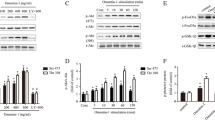Abstract
To explore the efficiency and mechanism of ovarian carcinoma gene therapy with the human fast-twitch skeletal muscle troponin I gene (Tnl-fast), Tnl-fast cDNA was transferred into human ovarian adenocarcinoma cell-line SK-OV-3. In vitro, the cell growth and cell cycle of Tnl-fast-, vector-, and mock-transfected cells were determined by MTT and flow cytometry assay, respectively. The conditioned media of Tnl-fast-, vector-, and mock-transfected SK-OV-3 cells were collected, and the cell proliferation inhibiting rates of human umbilical cord venous endothelial cells (HUVECs) by the three conditioned media were assayed. All the three cell lines were implanted into node mice, and the tumor growth, cell apoptosis, angiogenesis, and expression of Tnl-fast were observed or analyzed, respectively. In vitro, expression of Tnl-fast protein had no inhibiting effect on the growth of the dominant and stable transfectant cells, but endothelium, when compared with vector-transfected cells and nontransfected parental SK-OV-3 cells. Implantation of stable clone expressing Tnl-fast in the female BALB/c nude mice inhibits primary tumor growth by an average of 73%. The nude mice grafts expressing Tnl-fast exhibit a significant decrease of microvascular density, a higher rate of tumor cells apoptosis and a comparable proliferation rate as control. Our study, to our knowledge, shows the slowed down growth of the primary ovarian carcinoma, suggested that grafts were self-inhibitory by halting angiogenesis. Our data might also provide a novel useful strategy for cancer therapy by antiangiogenic gene therapy with a specific angiogenesis inhibitor Tnl-fast.
Similar content being viewed by others
References
Hanahan D, Folkman J. Patterns and emerging mechanisms of the angiogenic switch during tumorigenesis. Cell, 1996, 86(3): 353–364
Folkman J. Clinical applications of research on angiogenesis. N Engl J Med, 1995, 333(26): 1757–1763
Folkman J. Angiogenesis in cancer, vascular, rheumatoid and other disease. Nat Med, 1995, 1(1): 27–31
O’Reilly M S, Holmgren L, Shing Y, et al. Angiostatin: a novel angiogenesis inhibitor that mediates the suppression of metastases by a Lewis lung carcinoma. Cell, 1994, 79(2): 315–328
Kandel J, Bossy-Wetzel E, Radvanyi F, et al. Neovascularization is associated with a switch to the export of bFGF in the multistep development of fibrosarcoma. Cell, 1991, 66(6): 1095–1104
Ferrara N, Houck L, Jakeman L, et al. Molecular and biological properties of the vascular endothelial cell growth factor family of proteins. Endocr Rev, 1992, 13(1): 18–32
Dvorak H F, Brown L F, Detmar M, et al. Vascular permeability factor/vascular endothelial growth factor, microvascular hyperpermeability, and angiogenesis. Am J Pathol, 1995, 146(5): 1029–1039
Bussolino F, Mantovani A, Persico G. Molecular mechanisms of blood vessel formation. Trends Biochem Sci, 1997, 22(7): 251–256
Rastinejad F, Polverini P, Bouck N P. Regulation of the activity of a new inhibitor of angiogenesis by a cancer suppressor gene. Cell, 1989, 56(3): 345–355
Sharpe R J, Byer H R, Scott C F, et al. Growth inhibition of murine melanoma and human colon carcinoma by recombinant human platelet factor 4. J Natl Cancer Inst, 1990, 82(10): 848–853
Brooks P C, Montgomery A M, Rosenfeld M, et al. Integrin v3 antagonists promote tumor regression by inducing apoptosis of angiogenic blood vessels. Cell, 1994, 79(7): 1157–1164
Moses M A, Wiederschain D, Wu I, et al. Troponin I is present in human cartilage and inhibits angiogenesis. Proc Natl Acad Sci USA, 1999, 96(6): 2645–2650
Feldman L, Rouleau C. Troponin I inhibits capillary endothelial cell proliferation by interaction with the cell’s bFGF receptor. Microvasc Res, 2002, 63(1): 41–49
Moses M A, Klagsbrun M, Shing Y. The role of growth factors in vascular cell development and differentiation. Int Rev Cytol, 1995, 161: 1–48
Yamaoka M, Yamamoto T, Masaki T, et al. Inhibition of tumor growth and metastasis of rodent tumors by the angiogenesis inhibitor O-(chloroacetyl-carbamoyl) fumagillol (TNP-470; AGM-1470). Cancer Res, 1993, 53(18): 4262–4267
Chirivi R G, Garofalo A, Crimmin M J, et al. Inhibition of the metastatic spread and growth of B16-BL6 murine melanoma by a synthetic matrix metalloproteinase inhibitor. Int J Cancer, 1994, 58(3): 460–464
Kern B E, Balcom J H, Antoniu B A, et al. Troponin I peptide (Glu94-Leu123), a cartilage-derived angiogenesis inhibitor: in vitro and in vivo effects on human endothelial cells and on pancreatic cancer. J Gastrointest Surg, 2003, 7(8): 961–968
Zhu L, Perez-Alvarado G, Wade R. Sequencing of a cDNA encoding the human fast-twitch skeletal muscle isoform of troponin I. Biochim Biophys Acta, 1994, 1217(3): 338–340
Wei Y, Zhao X, Kariya Y, et al. Inhibition of proliferation and induction of apoptosis by abrogation of heat-shock protein (HSP) 70 expression in tumor cell. Cancer Immunol Immuother, 1995, 40(2): 73–78
Dameron K M, Volpert O V, Tainsky M A, et al. Control of angiogenesis in fibroblasts by p53 regulation of thrombospondin-1. Science, 1994, 265(5178): 1582–1584
Auerbach W, Auerbach R. Angiogenesis inhibition: A review. Pharmacol Ther, 1994, 63(3): 265–311
Shweiki D, Itin A, Soffer D, et al. Vascular endothelial growth factor induced by hypoxia may mediate hypoxia-induced angiogenesis. Nature, 1992, 359(6398): 843–845
Holmgren L, O’Reilly M S, Folkman J. Dormancy of metastases: balanced proliferation and apoptosis in the presence of angiogenesis suppression. Nat Med, 1995, 1(2): 149–153
Santin A D, Hermonat P L, Ravaggi A, et al. Secretion of vascular endothelial growth factor in ovarian cancer. Eur J Gynaecol Oncol, 1999, 20(3): 177–181
Cao Y, O’Reilly M S, Marshall B, et al. Expression of angiostatin cDNA in a murine fibrosarcoma suppresses primary tumor growth and produces long-term dormancy of metastases. J Clin Invest, 1998, 101(5): 1055–1063
Author information
Authors and Affiliations
Corresponding author
Rights and permissions
About this article
Cite this article
Xiong, G., Yang, L., Wei, Y. et al. Expression of the human fast-twitch skeletal muscle troponin I cDNA in a human ovarian carcinoma suppresses tumor growth. SCI CHINA SER C 50, 93–100 (2007). https://doi.org/10.1007/s11427-007-2032-7
Received:
Accepted:
Issue Date:
DOI: https://doi.org/10.1007/s11427-007-2032-7




